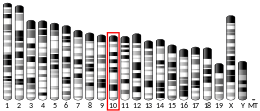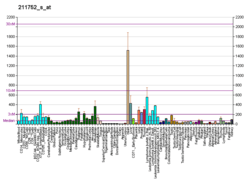NDUFS7
NADH dehydrogenase [ubiquinone] iron-sulfur protein 7, mitochondrial, also knowns as NADH-ubiquinone oxidoreductase 20 kDa subunit, Complex I-20kD (CI-20kD), or PSST subunit is an enzyme that in humans is encoded by the NDUFS7 gene.[5][6][7] The NDUFS7 protein is a subunit of NADH dehydrogenase (ubiquinone) also known as Complex I, which is located in the mitochondrial inner membrane and is the largest of the five complexes of the electron transport chain.[8]
Structure
The NDUFS7 gene is located on the p arm of chromosome 19 in position 13.3.[6] The NDUFS7 gene produces a 25 kDa protein composed of 238 amino acids.[9][10] The PSST subunit is highly conserved across evolutionary distances. Crystal structures and mutational studies indicate that it is one of the ubiquinone binding sites of Complex I, together with the TYKY (NDUFS8) subunit.[11] It has been proposed that PSST, along with TYKY, 49 kDa, ND1 and ND5 subunits interact with iron-sulfur clusters as part of the catalytic core of NADH dehydrogenase (ubiquinone).[12]
Function
The PSST subunit encoded by the NDUSF7 gene is one of over 40 subunits involved in the transfer of electrons from NADH to ubiquinone. Specifically, it is thought that the PSST subunit directly couples electron transfer between the iron-sulfur cluster N2 and ubiquinone, along with ubiquinone-binding ND1.[12] Functional evidence for the importance of PSST has been garnered from mutational studies in the obligate aerobic yeast, Yarrow lipolytic, which elucidated a central role in proton translocation that was reduced in mutant forms of the subunit.[13]
Clinical Significance
Mitochondrial complex I deficiency (MT-C1D) is caused by mutations affecting the NDUFS7 gene. Complex I deficiency is a disorder of the mitochondrial respiratory chain that causes a wide range of clinical manifestations, from lethal neonatal disease to adult-onset neurodegenerative disorders. Phenotypes include macrocephaly with progressive leukodystrophy, non-specific encephalopathy, cardiomyopathy, myopathy, liver disease, Leigh syndrome, Leber's hereditary optic neuropathy, and some forms of Parkinson's disease. Leigh syndrome is an early-onset progressive neurodegenerative disorder characterized by the presence of focal, bilateral lesions in one or more areas of the central nervous system including the brainstem, thalamus, basal ganglia, cerebellum and spinal cord, and is the most common mitochondrial encephalomyopathy. Clinical features depend on which areas of the central nervous system are involved and include subacute onset of psychomotor retardation, hypotonia, ataxia, weakness, vision loss, eye movement abnormalities, seizures, dysphagia, and lactic acidosis.[14][7][15]
Interactions
In addition to co-subunits for complex I, NDUFS7 has protein-protein interactions with ENO2 and ARRB2.[16][17]
References
- GRCh38: Ensembl release 89: ENSG00000115286 - Ensembl, May 2017
- GRCm38: Ensembl release 89: ENSMUSG00000020153 - Ensembl, May 2017
- "Human PubMed Reference:". National Center for Biotechnology Information, U.S. National Library of Medicine.
- "Mouse PubMed Reference:". National Center for Biotechnology Information, U.S. National Library of Medicine.
- Hyslop SJ, Duncan AM, Pitkänen S, Robinson BH (November 1996). "Assignment of the PSST subunit gene of human mitochondrial complex I to chromosome 19p13". Genomics. 37 (3): 375–80. doi:10.1006/geno.1996.0572. PMID 8938450.
- "Entrez Gene: NDUFS7 NADH dehydrogenase (ubiquinone) Fe-S protein 7, 20kDa (NADH-coenzyme Q reductase)".
- "NDUFS7 - NADH dehydrogenase [ubiquinone] iron-sulfur protein 7, mitochondrial precursor - Homo sapiens (Human) - NDUFS7 gene & protein". www.uniprot.org. Retrieved 2018-07-18.
- Donald Voet; Judith G. Voet; Charlotte W. Pratt (2013). "18". Fundamentals of biochemistry : life at the molecular level (4th ed.). Hoboken, NJ: Wiley. pp. 581–620. ISBN 9780470547847.
- Zong NC, Li H, Li H, Lam MP, Jimenez RC, Kim CS, Deng N, Kim AK, Choi JH, Zelaya I, Liem D, Meyer D, Odeberg J, Fang C, Lu HJ, Xu T, Weiss J, Duan H, Uhlen M, Yates JR, Apweiler R, Ge J, Hermjakob H, Ping P (Oct 2013). "Integration of cardiac proteome biology and medicine by a specialized knowledgebase". Circulation Research. 113 (9): 1043–53. doi:10.1161/CIRCRESAHA.113.301151. PMC 4076475. PMID 23965338.
- "NADH dehydrogenase [ubiquinone] iron-sulfur protein 7, mitochondrial". Cardiac Organellar Protein Atlas Knowledgebase (COPaKB).
- Angerer H, Nasiri HR, Niedergesäß V, Kerscher S, Schwalbe H, Brandt U (October 2012). "Tracing the tail of ubiquinone in mitochondrial complex I". Biochimica et Biophysica Acta (BBA) - Bioenergetics. 1817 (10): 1776–84. doi:10.1016/j.bbabio.2012.03.021. PMID 22484275.
- Schuler, Franz; Casida, John E. (2001-07-02). "Functional coupling of PSST and ND1 subunits in NADH:ubiquinone oxidoreductase established by photoaffinity labeling". Biochimica et Biophysica Acta (BBA) - Bioenergetics. 1506 (1): 79–87. doi:10.1016/S0005-2728(01)00183-9. ISSN 0005-2728. PMID 11418099.
- Ahlers PM, Zwicker K, Kerscher S, Brandt U (August 2000). "Function of conserved acidic residues in the PSST homologue of complex I (NADH:ubiquinone oxidoreductase) from Yarrowia lipolytica". The Journal of Biological Chemistry. 275 (31): 23577–82. doi:10.1074/jbc.M002074200. PMID 10811805.
- Smeitink J, van den Heuvel L (June 1999). "Human mitochondrial complex I in health and disease". American Journal of Human Genetics. 64 (6): 1505–10. doi:10.1086/302432. PMC 1377894. PMID 10330338.
- Triepels RH, van den Heuvel LP, Loeffen JL, Buskens CA, Smeets RJ, Rubio Gozalbo ME, Budde SM, Mariman EC, Wijburg FA, Barth PG, Trijbels JM, Smeitink JA (June 1999). "Leigh syndrome associated with a mutation in the NDUFS7 (PSST) nuclear encoded subunit of complex I" (PDF). Annals of Neurology. 45 (6): 787–90. doi:10.1002/1531-8249(199906)45:6<787::AID-ANA13>3.0.CO;2-6. PMID 10360771.
- "Interaction Details". IntAct Molecular Interaction Database.
- "Interaction Details". IntAct Molecular Interaction Database.
Further reading
- Maruyama K, Sugano S (January 1994). "Oligo-capping: a simple method to replace the cap structure of eukaryotic mRNAs with oligoribonucleotides". Gene. 138 (1–2): 171–4. doi:10.1016/0378-1119(94)90802-8. PMID 8125298.
- Suzuki Y, Yoshitomo-Nakagawa K, Maruyama K, Suyama A, Sugano S (October 1997). "Construction and characterization of a full length-enriched and a 5'-end-enriched cDNA library". Gene. 200 (1–2): 149–56. doi:10.1016/S0378-1119(97)00411-3. PMID 9373149.
- Loeffen JL, Triepels RH, van den Heuvel LP, Schuelke M, Buskens CA, Smeets RJ, Trijbels JM, Smeitink JA (December 1998). "cDNA of eight nuclear encoded subunits of NADH:ubiquinone oxidoreductase: human complex I cDNA characterization completed". Biochemical and Biophysical Research Communications. 253 (2): 415–22. doi:10.1006/bbrc.1998.9786. PMID 9878551.
- Triepels RH, Hanson BJ, van den Heuvel LP, Sundell L, Marusich MF, Smeitink JA, Capaldi RA (March 2001). "Human complex I defects can be resolved by monoclonal antibody analysis into distinct subunit assembly patterns". The Journal of Biological Chemistry. 276 (12): 8892–7. doi:10.1074/jbc.M009903200. PMID 11112787.
- Schuler F, Casida JE (July 2001). "Functional coupling of PSST and ND1 subunits in NADH:ubiquinone oxidoreductase established by photoaffinity labeling". Biochimica et Biophysica Acta (BBA) - Bioenergetics. 1506 (1): 79–87. doi:10.1016/S0005-2728(01)00183-9. PMID 11418099.
- Ugalde C, Janssen RJ, van den Heuvel LP, Smeitink JA, Nijtmans LG (March 2004). "Differences in assembly or stability of complex I and other mitochondrial OXPHOS complexes in inherited complex I deficiency". Human Molecular Genetics. 13 (6): 659–67. doi:10.1093/hmg/ddh071. PMID 14749350.
- Ricci JE, Muñoz-Pinedo C, Fitzgerald P, Bailly-Maitre B, Perkins GA, Yadava N, Scheffler IE, Ellisman MH, Green DR (June 2004). "Disruption of mitochondrial function during apoptosis is mediated by caspase cleavage of the p75 subunit of complex I of the electron transport chain". Cell. 117 (6): 773–86. doi:10.1016/j.cell.2004.05.008. PMID 15186778.
- Lebon S, Rodriguez D, Bridoux D, Zerrad A, Rötig A, Munnich A, Legrand A, Slama A (April 2007). "A novel mutation in the human complex I NDUFS7 subunit associated with Leigh syndrome". Molecular Genetics and Metabolism. 90 (4): 379–82. doi:10.1016/j.ymgme.2006.12.007. PMID 17275378.
- Lebon S, Minai L, Chretien D, Corcos J, Serre V, Kadhom N, Steffann J, Pauchard JY, Munnich A, Bonnefont JP, Rötig A (2007). "A novel mutation of the NDUFS7 gene leads to activation of a cryptic exon and impaired assembly of mitochondrial complex I in a patient with Leigh syndrome". Molecular Genetics and Metabolism. 92 (1–2): 104–8. doi:10.1016/j.ymgme.2007.05.010. PMID 17604671.




